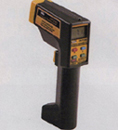Bob has received a call from the dispatcher about a system that is not cooling. The job is a small building with a 5-ton cooling unit. The owner said that the unit cools part of the time, but the cooling stops from time to time, even though the outdoor unit continues to run.
Bob arrived at the job and found that the conditions inside the building were not cool. It was 85°F outside and 80° inside. The building had a large lighting load. Bob checked the thermostat and it was set for 72°. He talked to the owner but did not discover anything.
Bob went to the outdoor unit. It was running and warm air was coming out of the top. He felt the suction line and it was cool. The liquid line was warm. All seemed normal, and Bob was confused. He went to the truck to get his gauges, and when he got back, he noticed that the compressor didn’t seem to be running. Looks like a clue, he thought.

Figure 1. This photo is of an infrared thermometer. It sends out an infrared beam and measures the line temperature. It is particularly good for fast readings and you don’t have to fasten any temperature leads on the line. (Figures are from Refrigeration & Air Conditioning Technology, 5th Edition, by William Whitman, William Johnson, and John Tomczyk, published by Delmar Cengage Learning.) (©Delmar Cengage Learning.) (Click on the image for an enlarged view.)
As Bob was scratching his head, Btu Buddy showed up. He said, “What is the matter, Bob? Are you confused about something?”
Bob explained what was happening to Btu Buddy.
Btu Buddy said, “Fasten your gauges to the system and let’s do some testing.”
Bob fastened his gauges to the system and waited for a few minutes and the compressor started again. The suction pressure was a little high and the head pressure was a little low.
Btu Buddy then said, “Get a long screwdriver and some plastic to cover the condenser and force the head pressure up.”
Bob returned with the items and partially covered the condenser. He allowed the head pressure to rise to 350 psig for this R-22 system. The suction pressure rose to 90 psig.
Btu Buddy said, “Use the screwdriver to listen to the compressor discharge line and shut the compressor off.”
When Bob shut the compressor off, he said, “There is a loud whistling inside the compressor.”
Btu Buddy then said, “Feel the suction line on the compressor.”
Bob felt the suction line and said, “It is warm, instead of cool. I would swear it was cool while it was running.”
Btu Buddy said, “It was cool while it was running, but it got warm when you shut it off. You have two symptoms. The suction line gets warm when you shut off the compressor and the compressor makes a whistling sound inside. The discharge line is also running too hot. What do you suppose could be the problem?”
Bob said, “The suction line must be getting warm from hot gas. The only way that hot gas could get to the suction line when the compressor is shut off is from the high side. I suppose that must mean that there is a high side leak inside the compressor.”

Figure 2. This is an example of a compressor with a high pressure leak. This could be from a pipe that is split, a blown head gasket, or a cracked casting. (©Delmar Cengage Learning.) (Click on the image for an enlarged view.)
Bob asked, “Why does the discharge line get so hot?”
Btu Buddy explained, “The hot gas is recirculating and getting hotter and hotter. Only a small amount of gas is recirculating, so it only takes a little time for the compressor to get hot. Your first clue was picked up in the general inspection before you applied the gauges. It was the hot discharge line. You were quick to pick up on it.”
Bob went to the customer and arranged to change the compressor later that day. Meanwhile, he suggested that the system be shut off at the room thermostat to keep from possibly having a compressor motor burn to deal with.
As they were riding away, Btu Buddy said, “That was good advice to shut the system off to prevent a motor burn. It was also correct to shut it off at the room thermostat and not shut the breaker off. If you had shut the breaker off, there would be refrigerant migrated to the compressor crankcase. It is much harder to recover the refrigerant when it is in the oil.”
Bob said, “I did that on purpose and for those reasons. I also disconnected the wire to the compressor contactor. If the owner or someone else in the building fools with the thermostat, the compressor will not start.”
Btu Buddy said, “You are really catching on, Bob.”
Publication date:05/23/2011


Report Abusive Comment